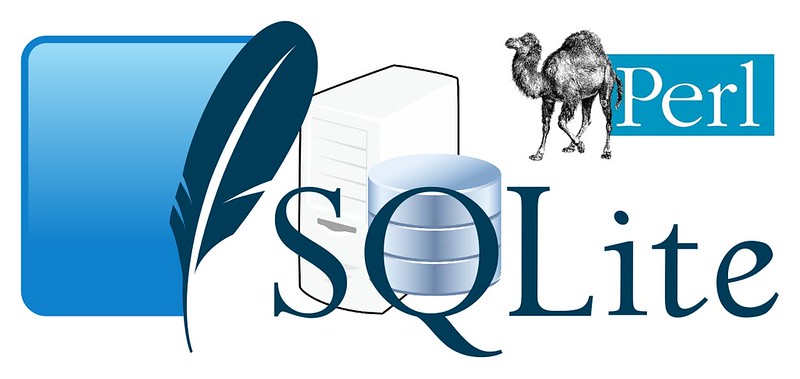http://xmodulo.com/access-sqlite-database-perl.html
SQLite is a zero-configuration, server-less, file-based transactional database system. Due to its lightweight, self-contained, and compact design, SQLite is an extremely popular choice when you want to integrate a database into your application. In this post, I am going to show you how to create and access a SQLite database in Perl script. The Perl code snippet I present is fully functional, so you can easily modify and integrate it into your project.

If you run the script, you should see SQLite in the output.
A successful run of the above Perl script will create a SQLite database file named "xmodulo.db", and show the following output.
SQLite is a zero-configuration, server-less, file-based transactional database system. Due to its lightweight, self-contained, and compact design, SQLite is an extremely popular choice when you want to integrate a database into your application. In this post, I am going to show you how to create and access a SQLite database in Perl script. The Perl code snippet I present is fully functional, so you can easily modify and integrate it into your project.

Preparation for SQLite Access
I am going to use SQLite DBI Perl driver to connect to SQLite3. Thus you need to install it (along with SQLite3) on your Linux system.Debian, Ubuntu or Linux Mint
$ sudo apt-get install sqlite3 libdbd-sqlite3-perl
CentOS, Fedora or RHEL
$ sudo yum install sqlite perl-DBD-SQLite
After installation, you can check if the SQLite driver is indeed available by using the following script.
1
2
3
4
5
| #!/usr/bin/perluse DBI;my @drv = DBI->available_drivers();print join("\n", @drv), "\n"; |
DBM ExampleP File Gofer Proxy SQLite Sponge
Perl SQLite Access Example
Here is the full-blown Perl code example of SQLite access. This Perl script will demonstrate the following SQLite database management routines.- Create and connect to a SQLite database.
- Create a new table in a SQLite database.
- Insert rows into a table.
- Search and iterate rows in a table.
- Update rows in a table.
- Delete rows in a table.
1
2
3
4
5
6
7
8
9
10
11
12
13
14
15
16
17
18
19
20
21
22
23
24
25
26
27
28
29
30
31
32
33
34
35
36
37
38
39
40
41
42
43
44
45
46
47
48
49
50
51
52
53
54
55
56
57
58
59
60
61
62
63
64
65
66
67
68
69
70
71
72
73
74
75
76
77
78
79
80
81
82
83
84
85
| #!/usr/bin/perluse DBI;use strict;# define database name and drivermy $driver = "SQLite";my $db_name = "xmodulo.db";my $dbd = "DBI:$driver:dbname=$db_name";# sqlite does not have a notion of username/passwordmy $username = "";my $password = "";# create and connect to a database.# this will create a file named xmodulo.dbmy $dbh = DBI->connect($dbd, $username, $password, { RaiseError => 1 }) or die $DBI::errstr;print STDERR "Database opened successfully\n";# create a tablemy $stmt = qq(CREATE TABLE IF NOT EXISTS NETWORK (ID INTEGER PRIMARY KEY AUTOINCREMENT, HOSTNAME TEXT NOT NULL, IPADDRESS INT NOT NULL, OS CHAR(50), CPULOAD REAL););my $ret = $dbh->do($stmt);if($ret < 0) { print STDERR $DBI::errstr;} else { print STDERR "Table created successfully\n";}# insert three rows into the table$stmt = qq(INSERT INTO NETWORK (HOSTNAME,IPADDRESS,OS,CPULOAD) VALUES ('xmodulo', 16843009, 'Ubuntu 14.10', 0.0));$ret = $dbh->do($stmt) or die $DBI::errstr;$stmt = qq(INSERT INTO NETWORK (HOSTNAME,IPADDRESS,OS,CPULOAD) VALUES ('bert', 16843010, 'CentOS 7', 0.0));$ret = $dbh->do($stmt) or die $DBI::errstr;$stmt = qq(INSERT INTO NETWORK (HOSTNAME,IPADDRESS,OS,CPULOAD) VALUES ('puppy', 16843011, 'Ubuntu 14.10', 0.0));$ret = $dbh->do($stmt) or die $DBI::errstr;# search and iterate row(s) in the table$stmt = qq(SELECT id, hostname, os, cpuload from NETWORK;);my $obj = $dbh->prepare($stmt);$ret = $obj->execute() or die $DBI::errstr;if($ret < 0) { print STDERR $DBI::errstr;}while(my @row = $obj->fetchrow_array()) { print "ID: ". $row[0] . "\n"; print "HOSTNAME: ". $row[1] ."\n"; print "OS: ". $row[2] ."\n"; print "CPULOAD: ". $row[3] ."\n\n";}# update specific row(s) in the table$stmt = qq(UPDATE NETWORK set CPULOAD = 50 where OS='Ubuntu 14.10';);$ret = $dbh->do($stmt) or die $DBI::errstr;if( $ret < 0 ) { print STDERR $DBI::errstr;} else { print STDERR "A total of $ret rows updated\n";}# delete specific row(s) from the table$stmt = qq(DELETE from NETWORK where ID=2;);$ret = $dbh->do($stmt) or die $DBI::errstr;if($ret < 0) { print STDERR $DBI::errstr;} else { print STDERR "A total of $ret rows deleted\n";}# quit the database$dbh->disconnect();print STDERR "Exit the database\n"; |
Database opened successfully Table created successfully ID: 1 HOSTNAME: xmodulo OS: Ubuntu 14.10 CPULOAD: 0 ID: 2 HOSTNAME: bert OS: CentOS 7 CPULOAD: 0 ID: 3 HOSTNAME: puppy OS: Ubuntu 14.10 CPULOAD: 0 A total of 2 rows updated A total of 1 rows deleted Exit the database
Troubleshooting
If you attempt to access SQLite in Perl without installing SQLite DBI driver, you will encounter the following error. You must install DBI driver as describe at the beginning to fix this error.Can't locate DBI.pm in @INC (@INC contains: /usr/local/lib64/perl5 /usr/local/share/perl5 /usr/lib64/perl5/vendor_perl /usr/share/perl5/vendor_perl /usr/lib64/perl5 /usr/share/perl5 .) at ./script.pl line 3. BEGIN failed--compilation aborted at ./script.pl line 3.

No comments:
Post a Comment